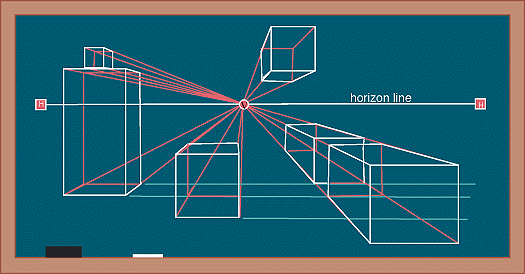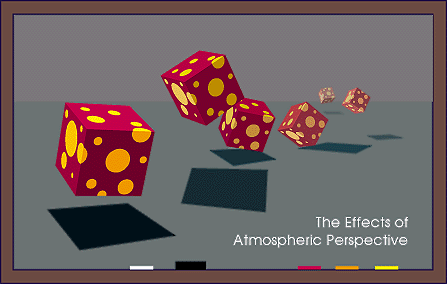To understand and apply depth cues as they apply to the creation of spatial illusions in two-dimensional art.
In the three-dimensional world, things occupy space. But what happens when, as an artist, you want to convey a feeling of space or depth and your materials are essentially flat? We have a variety of depth cues we can use to indicate or suggest the illusion of three-dimensional space.(see illustrations of depth cues)
Because we exist in the physical world, it is challenging to learn how to translate what we understand intuitively in three dimensions to the two dimensional picture plane.
Imagine looking at a set of large packing crates stacked above and below your eye level. When you look towards the horizon, it appears that the parallel edges of the boxes actually converge. This point of convergence, always on the horizon line, is called the vanishing point. We know in our mind's eye that edges of the boxes do not actually come together, but we can use this illusion on the flat picture plane to suggest deep space.
(the illustrations below are from The Chalkboard, School of Art, Southern Arkansas University).

The boxes appear to get smaller as they recede towards the horizon. If you can imagine first looking at your feet, then scanning up to the horizon line, you will see that these boxes appear to climb vertically in the picture plane. Vertical location is a powerful device for suggesting depth: for objects below the horizon line, the higher they are positioned in the picture plane, the further back they will appear.
If you were to draw lines connecting the tops and bottoms of the boxes, you would find that these lines also converge on the vanishing point. The implied diagonal lines also suggest spatial depth.
From our vantage point, the boxes appear to overlap. Whenever we put one graphic element in front of another, we are creating the illusion of space using overlapping.
One box floats above the horizon line. Objects above the horizon line also obey the laws of perspective. One exception to the rule of vertical location above: the lower objects above the horizon line are, the farther away they appear. This is important to remember when drawing clouds.
In the age of flight, space travel, and underwater exploration, one's vantage point is often well above or below "ground level." While we normally equate the horizon line with one's eye level, when viewing a scene from above or below we may have little or no relationship to the actual horizon line. We can still use depth cues to suggest receding space.
One of the most important ways the painters and photographers suggest depth is with atmospheric or aerial perspective. By decreasing the saturation of colors and making edges less distinct for objects at a distance, we can create the impression of great depth and space.

As you may have already guessed, you can also use some of these same techniques to deny spatial illusions. While we have seen how depth cues can be used to create virtual three-dimensional space, the rules can be reversed to flatten pictorial space. What would happen, for example, if the most saturated colors were applied to the smallest objects in the distance?
Ansel Adams, Joseph Albers, Alberti, Canaletto, Thomas Cole, Leonardo Da Vinci, Max Ernst, Robert Henri, Hans Hoffman, Dorothea Lange, Giovanni Battista Piranesi, Man Ray, Bridget Riley, Utamoro, Ludwig Mies Van der Rohe, Vincent Van Gogh,
Bachelard, Gaston, The Poetics of Space
Gombrich, E.H., Art and Illusion: A Study in the Psychology of Pictorial Representation. Princeton, NJ: Princeton University Press, 1961.
White, J., The Birth and Rebirth of Pictorial Space. 2nd ed. New York: Harper and Row, 1973.
Identity 1. 2. Protest and Persuasion 1. 2. Science and Technology 1. Collaboration 1. Other Voices Art for Hire 1. Fantasy 1. Fantastic Illusions (thanks to Isa Gordon) The Natural World 1. Spirit Worlds 1. Mining for Ideas 1.
A.
B.
C.
D.
E.
F.
G.
H.
I.
J.